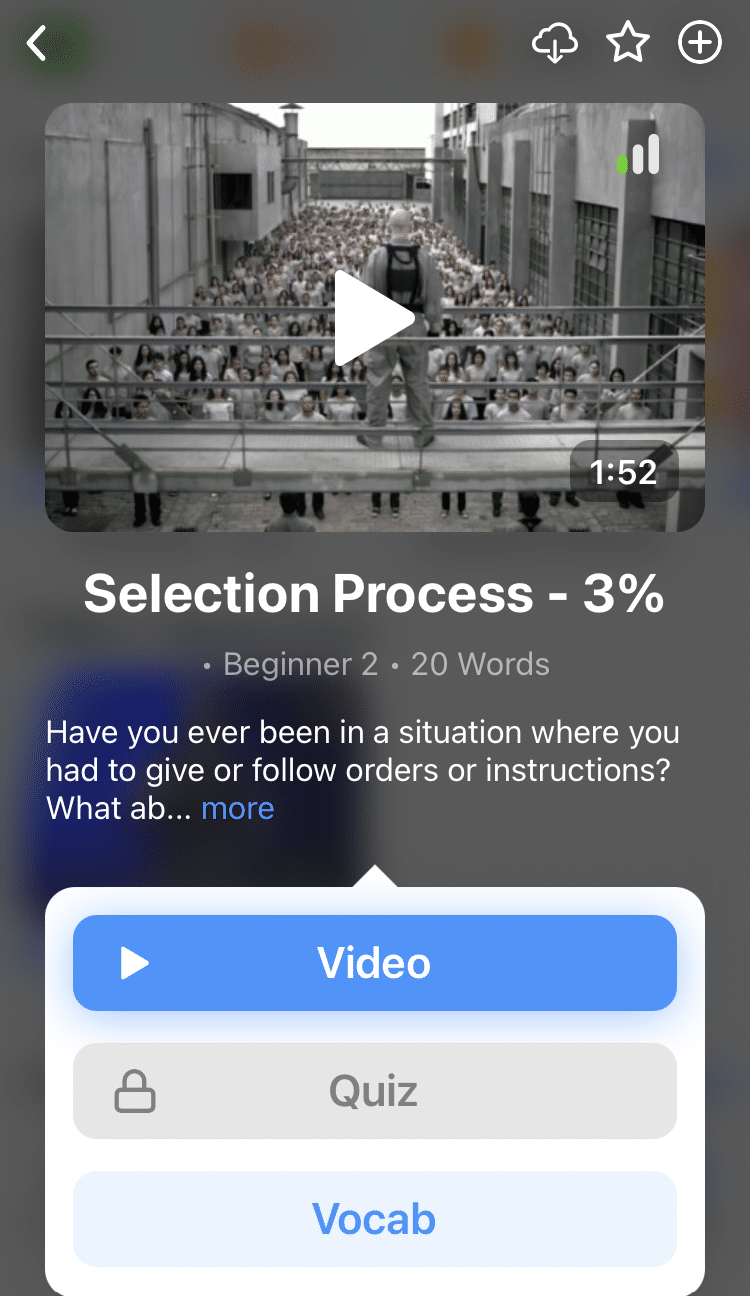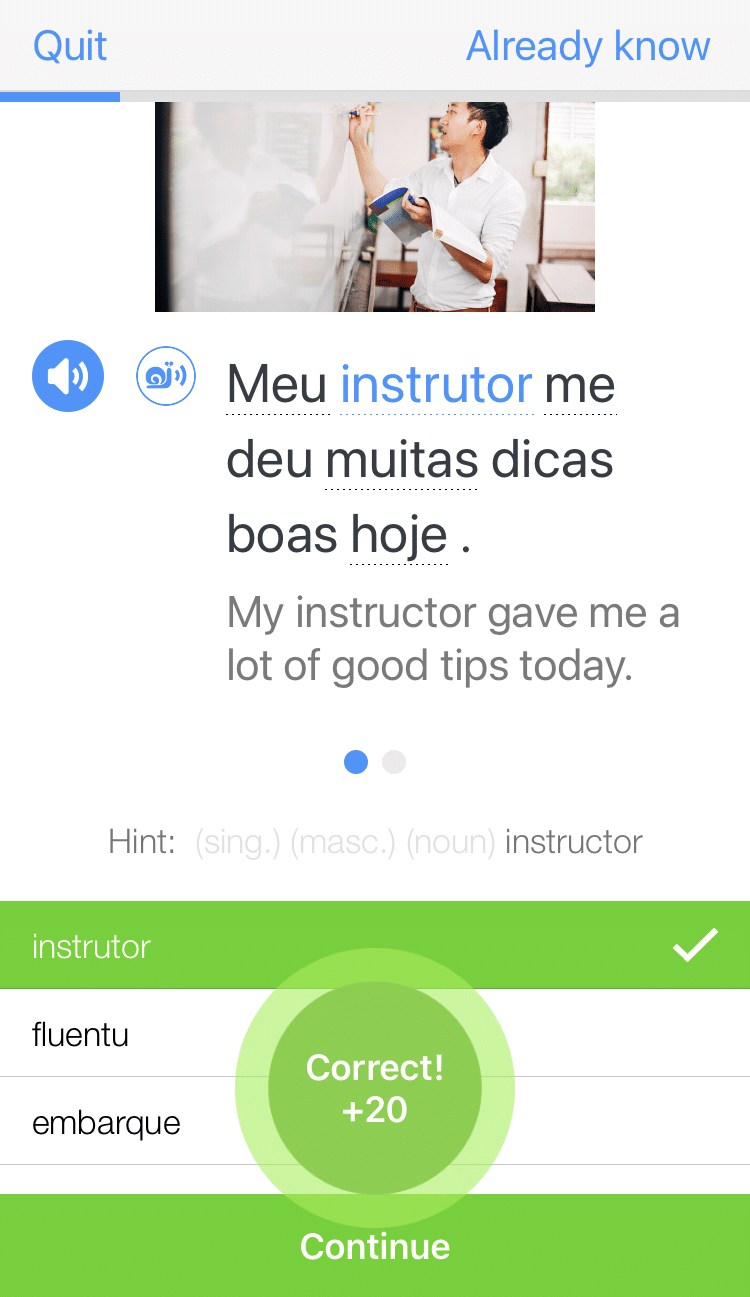
How to Learn Portuguese Grammar: 5 Steps to Successful Sentence Structure
It’s time to face the facts: If you want to get fluent in Portuguese, at some point you’ll need to sit down and do some grammar drills.
Don’t worry: studying Portuguese grammar doesn’t have to be dreary and difficult.
All you need is a plan.
Grab a pen and paper, because we’re about to unfold a five-step plan that’ll make learning Portuguese grammar a whole lot easier!
Contents
- 1. Use Your Knowledge of English Grammar to Target Portuguese Study Areas
- 2. Study the Different Parts of Speech
- 3. Learn Portuguese Sentence Construction
- 4. Put Everything Together
- 5. Keep Practicing What You Learned
- And One More Thing…
Download: This blog post is available as a convenient and portable PDF that you can take anywhere. Click here to get a copy. (Download)
1. Use Your Knowledge of English Grammar to Target Portuguese Study Areas
Start learning Portuguese by looking at what you already know: English.
This step can help you plan your studies according to your own strengths, weaknesses and personal goals.
First, examine your weaknesses in English. Knowing which English language grammar rules you struggle with can help you gain a clearer idea of the different problem areas you might need to prioritize in Portuguese.
For instance, if you often have trouble choosing the correct homonym (like their/there/they’re), you may also struggle to distinguish between verb couples like por and para, or ser and estar.
If you can never remember which form of an irregular verb to use in the past participle (sing → sung), then that’s something you should devote more attention to in Portuguese, as well.
Write down everything that gives you trouble in English. That’s your “problem areas” plan, which you should devote extra study time to.
Once you have your weaknesses straight, it’s time to look at your strengths and similarities between English and Portuguese.
Portuguese has Latin roots, while English borrows words from Latin, German, French, Dutch among many other languages. This means that, while the two languages are vastly different in appearance, they share a root and therefore have some resemblances.
This Latin connection will be instrumental in your learning as there are quite a few instances where both languages follow similar patterns.
For instance, take a look at these suffixes and their English equivalents:
Portuguese: -ado/-ada → English: -ed.
For example: interessado/interessada (interested), criticado/criticada (criticized), analisado/analisada (analyzed).
Portuguese: -ável/-ível → English: -ible/-able.
For example: horrível (horrible), amável (lovable), irresponsável (irresponsible).
There are quite a number of other similarities between the two languages, like English-Portuguese cognates (words that sound similar in both languages and mean the same thing) and even the word order used to form a sentence (more on this in step three).
Just as there are similarities, there are also a few differences. Here are some of the main linguistic divergences you need to consider closely:
- All words in Portuguese are gendered. We’ll take a closer look at this in a bit, but generally, words ending in -o are mostly masculine while those ending in -a are feminine.
- Adjective placement is flipped. in English, the adjective comes before the noun. In Portuguese, the opposite is true.
For instance, if you were to talk about “a blue house” you’d say uma casa azul (literally: “a house blue”).
- Intonation and context. In Portuguese, you usually differentiate questions and answers by context and intonation, not word order like in English.
For example, the statement Eu tenho que ir (I have to go) can be transformed into a question just by adding a question mark and raising your intonation at the end of the sentence: Eu tenho que ir? (Do I have to go?).
All of this will become clearer as you break grammar down further—which is what we do in the next step.
2. Study the Different Parts of Speech
Grammar, as you already know, is comprised of several linguistic elements.
Whether you’re opting to fully teach yourself the language or you’ve signed up for an immersive course, understanding the role of the different parts of a sentence will make you more adept at using them.
Below, we break down some of the most common elements of grammar and parts of speech in Portuguese, with some links for further study wherever necessary.
Go down the list and make note of anything you don’t know well. This, combined with your “English weaknesses” list from the step above, will form a focused study plan for you.
Get into the nooks and crannies of Portuguese grammar with the categories that follow!
Articles
Articles are used to determine or identify a noun. In English, the main articles are “the,” “a” and “some.”
Here are the Portuguese alternatives:
o/a — the masculine/feminine versions of “the”
um/uma — masculine/feminine forms of “a”
uns/umas — masculine/feminine for “some”
Notice that the articles have gendered and pluralized versions—articles in Portuguese must agree in gender and number with the noun they’re attached to.
We recommend you study nouns with an article attached, to better remember its gender for future use.
Adjectives
These are words that describe nouns and other adjectives. Most Portuguese adjectives have a masculine and feminine counterpart, though there are exceptions:
- Vermelho/vermelha (red), gordo/gorda (fat), pequeno/pequena (small) are examples of gendered adjectives. They’ll agree with the noun they’re modifying.
- Cinza (gray), marrom (brown) and violeta (violet) are examples of adjectives that are gender-neutral. They won’t change their form no matter what noun they’re describing.
As we mentioned before, adjectives in Portuguese usually go after the noun. Remember this!
Nouns
Nouns are people, places or things. They’re your standard naming words, like: cat (gato), mountains (montanhas), bread (pão).
Which nouns should you learn? Start with the 1,000 most common Portuguese nouns.
Now that we’ve introduced all three parts of speech, let’s take a closer look at how articles, nouns and adjectives agree with each other’s gendered form.
Take the simple phrase “the blue moon.” The Portuguese word for moon (lua) is feminine, so it would need to be preceded by the feminine article a (the) and followed by the adjective azul: a lua azul (literally: “the moon blue”).
If we were speaking of a red moon, instead, you’d use the feminine form of the word “red,” vermelha.
Just by knowing three parts of speech, you can already begin piecing together a basic sentence!
Proper Nouns
This one’s easy. Proper nouns are those you capitalize in English, the official names.
These include the names of countries (Estados Unidos, Itália, Espanha), people (João, Maria) or organizations (Organização das Nações Unidas — The United Nations).
Many names—like the names of people—barely change or don’t change at all in Portuguese. Others—like the names of countries, cities and other places—might look different but still be recognizable.
This part of speech is often overlooked: Study the slight differences to sound more like a native.
Adverbs
These are words that modify a verb, adjective or another adverb, typically answering questions like “how,” “at what time,” “to what degree.”
Some Portuguese examples include:
Rapidamente — Quickly
Aqui — Here
Menos — Less/Minus
Quando — When
As a side note, -mente from the first example is the the adverb ending stand-in for the English -ly. If you see -mente, you’re most likely looking at an adverb.
Study up on some common Portuguese adverbs to add more details to your sentences.
Verbs
We could probably spend hours talking about Portuguese verbs. The main thing to note is that Portuguese has more verb tenses than English—and quite a few irregular verbs, to boot.
There are a handful of essentials you’ll need to learn extra well, since they’re used extremely often:
Ser and estar — To be
Ter and haver — To have
Fazer — To do
In instances where an English verb has two Portuguese equivalents, take some time to learn about the differences and how each version is used.
Ser, for example, is the form of “to be” you’d use when talking about yourself: Eu sou forte (I am strong), whereas estar might be used to describe a temporary status, such as where you are: Eu estou aqui (I am here).
You’ll also need to learn the various tenses in Portuguese and the forms each verb takes for them.
Once you know the rules, you’ll need to learn the exceptions, the Portuguese irregular verbs. This is where your English knowledge will come in handy again: A lot of the irregular verbs in Portuguese are also irregular in English.
Make a list of any verbs or tenses that give you trouble and memorize them! Verbs are arguably the most important—and most difficult—aspect of Portuguese grammar to learn. Get them right to sound more natural.
Prepositions
Prepositions show the relationship between objects in time and space. They include words like:
Desde — Since
For example: Eu aprendo música desde pequena. (I’ve been learning music since I was little.)
Antes — Before
For example: Lave as mãos antes de jantar. (Wash your hands before dinner.)
Sem — Without
For example: Fiz isso sem ajuda. (I did this without any help.)
Prepositions can add detail and an exact value to your sentences, so it’s a good idea to learn as many as you can.
Interjections
Also called exclamations, interjections are used to communicate emotion:
Ai! — Ouch!
Hein!? — Huh!?
Graças a Deus — Thank God
They’re not essential to Portuguese but they are essential to truly sound like a native.
Pronouns
Pronouns are words that substitute nouns, like “I,” “me,” “he/she,” “they,” etc.
Portuguese pronouns work the same way as English ones, but they vary slightly according to the dialect. Here are two examples where this happens:
Você/Tu — You
The former is almost exclusively used in Brazil; the latter is used in Portugal and some Brazilian regions.
O senhor/A senhora — You
The formal way of saying “you” in Brazilian Portuguese.
Pronouns are used very often (since repeating nouns over and over gets old fast) so learn them well!
Contractions
Contractions are created when two words are merged together into one (like “can’t” or “they’re”). They help maintain the flow of conversation by shortening some commonly used word combinations.
Some Portuguese examples include:
Dele/dela — His/Hers
Num/numa — In/On some
Destes/destas — Of these
Nos/Nas — On the
While English mostly combines forms of “to be,” pronouns and the word “not” into conjunctions, Portuguese has lots of them.
Numbers
Okay, they’re not technically a part of speech, but numbers are really important! We use them constantly in our everyday life.
Um, dois, três, quatro, cinco, seis, sete, oito, nove, dez—that’s the first ten to get you started!
Can you count up to 1,000?
3. Learn Portuguese Sentence Construction
Now you know some words, and you even know the basics of using them. Let’s put them together into sentences by learning Portuguese word order.
Break things down: Your sentences will have a subject, verb, object and phrase complement—in that order.
To illustrate this, let’s look at this sentence: Ela tem uma casa na praia (“She has a beach house” or “She has a house on the beach”).
Ela (she) is the subject, tem (has) is the verb, uma casa (a house) is the object and na praia (on the beach) is the phrase complement.
As previously mentioned, the word order for questions and answers often doesn’t change in Portuguese. The exception is when you’re using question words (like “why” or “where”)—more on this in a moment.
One crucial difference between English and Portuguese sentence structure is that in Portuguese, sometimes the subject of a sentence can be hidden. Since verb conjugation implies the subject, it’s often perfectly acceptable to simply drop it.
For example, you might say Vamos estudar amanhã ([We’re] going to study tomorrow) instead of expressing it in full: Nós vamos estudar amanhã (We are going to study tomorrow).
That being said, direct questions that use a question word (like where or how) will have more clear-cut subjects. For example, in the sentence Onde (é que) ele vai? (Where is he going?) it’s obvious that the subject is ele (he). You can also see from this example how word order shifts when asking direct questions.
The last thing to note at this stage is how to form negative sentences. This is simple enough: just add a negating word before your verb. That’s all!
For example:
Eu não quero estudar. — I don’t want to study.
Eu nunca como carne. — I never eat meat.
Nós não fomos ao parque. — We didn’t go to the park.
4. Put Everything Together
Now that we’ve covered most of the theoretical groundwork, it’s time to put these skills into practice.
Dedicate some time to a Portuguese vocabulary revision, then start learning some essential everyday phrases. Once you’re confident enough to proceed, write up some sentences using all those rules and conventions you’ve been studying so diligently.
The best way to make your writing practice stick is by alternating between jotting things down physically in a notebook and typing them up on a computer.
The former will help with memorization (writing things physically helps us remember them), while the latter can help ensure you’re spelling everything correctly—regardless of which Portuguese dialect you’re writing in.
If you’re feeling ambitious, you can even keep a diary or a blog in Portuguese for practice. It may be difficult at first, but the more you write, the easier it’ll get!
And speaking of practice…
5. Keep Practicing What You Learned
In the end, learning grammar doesn’t have to be a strenuous task—you just need to strike the right balance between theory and practice.
The way to do that is to simply diversify your resources a bit. Some of the key materials you should equip yourself with include:
- Traditional grammar exercises. You can’t go wrong with the classics!
- A good textbook. Textbooks guide you through grammar lessons in an organized way, building on what you’ve learned. A good one also has plenty of exercises for practice.
- Interactive online resources. Here’s where the fun comes in! Not only are these great grammatical aides, they can also help with vocabulary-building.
Use all those fun learning weapons you probably already know and love: your favorite podcasts, blogs, TED Talks, social media, TV series and movies. Not only will these keep you motivated and entertained, they’ll showcase how all the theory you’ve been learning is applied in genuine, real-life contexts and interactions.
The best way to reinforce your Portuguese grammar learning is to hear it being used by actual Portuguese speakers!
Now that we’ve given you all the tools, it’s time to make the most of them. Start paving the path towards Portuguese grammar greatness, one part of speech at a time!
And One More Thing…
If you've made it this far that means you probably enjoy learning Portuguese with engaging material and will then love FluentU.
FluentU takes authentic videos—like music videos, movie trailers, news and inspiring talks—and turns them into personalized Portuguese lessons.
Other sites use scripted content. FluentU uses a natural approach that helps you ease into the Portuguese language and culture over time. You’ll learn Portuguese as it’s actually spoken by real people.
FluentU has a wide variety of videos, as you can see here:

FluentU brings native videos within reach with interactive transcripts. You can tap on any word to look it up instantly. Every definition has examples that have been written to help you understand how the word is used. If you see an interesting word you don’t know, you can add it to a vocab list.

Review a complete interactive transcript under the Dialogue tab, and find words and phrases listed under Vocab.

Learn all the vocabulary in any video with FluentU’s robust learning engine. Swipe left or right to see more examples of the word you’re on.

The best part is that FluentU keeps track of the vocabulary that you’re learning, and gives you extra practice with difficult words. It'll even remind you when it’s time to review what you’ve learned. Every learner has a truly personalized experience, even if they’re learning with the same video.
You can try FluentU for free for 2 weeks. Click here to check out the website or download the iOS app or Android app.
Download: This blog post is available as a convenient and portable PDF that you can take anywhere. Click here to get a copy. (Download)


